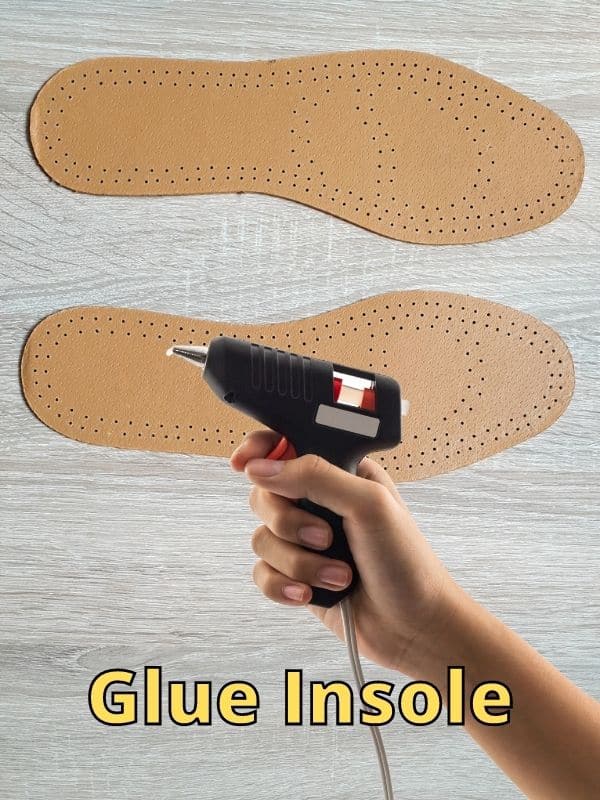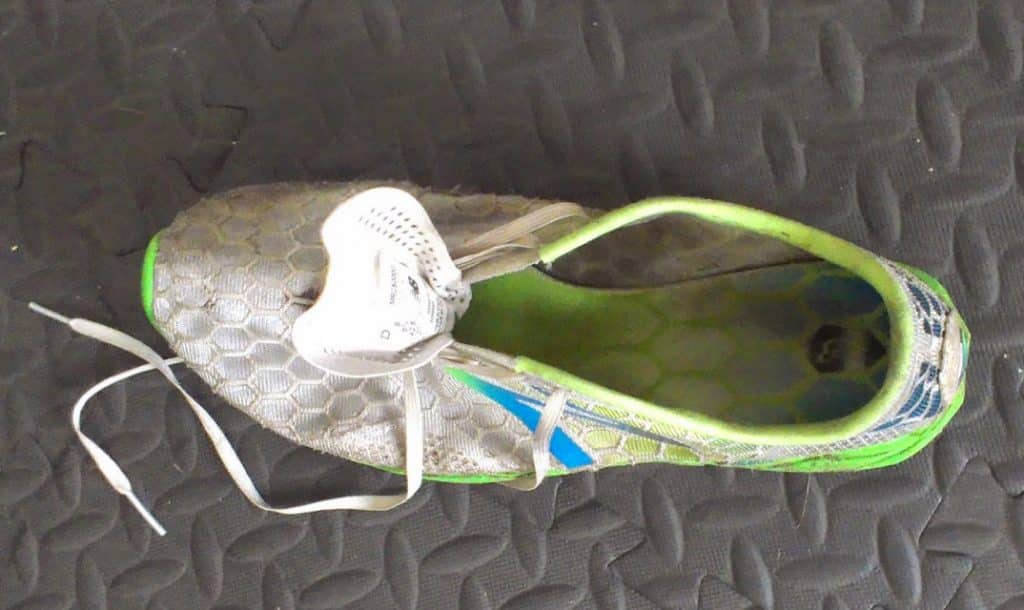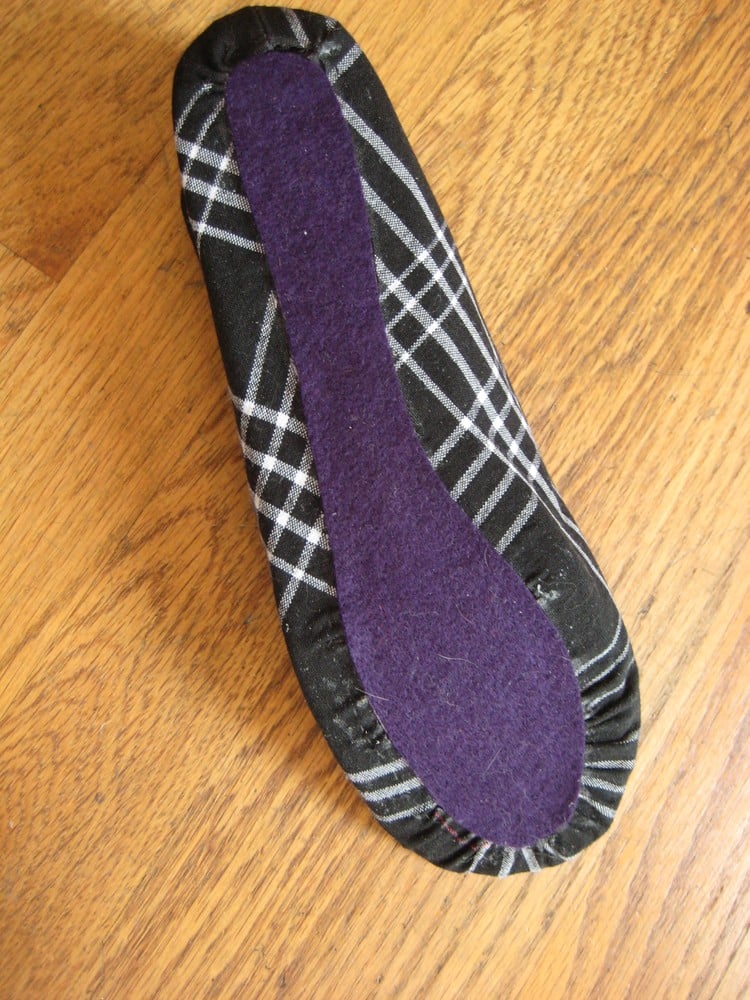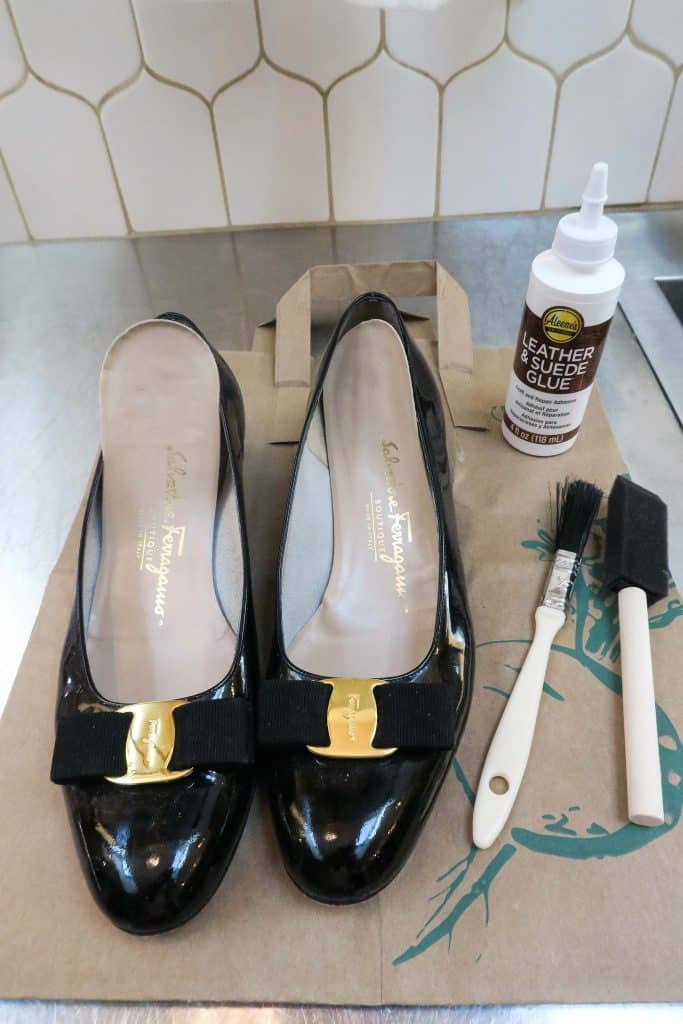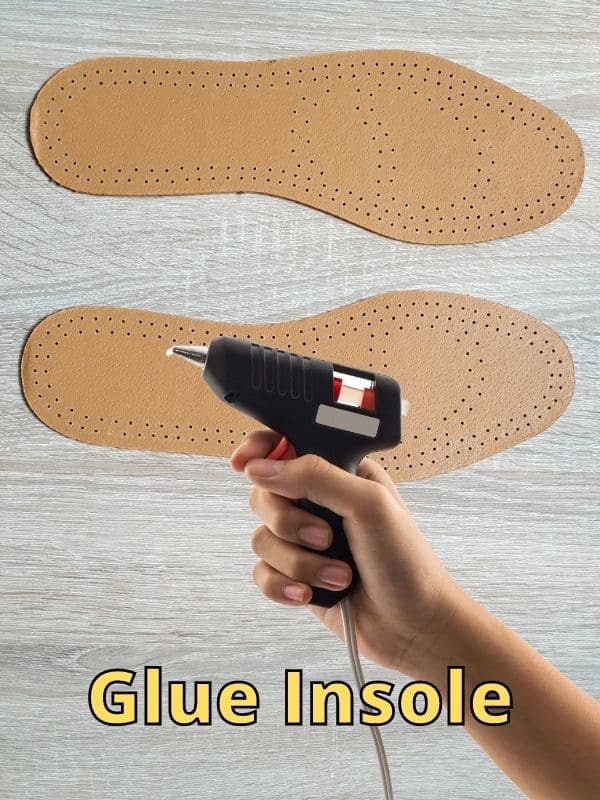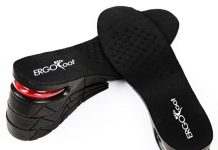Do you constantly adjust your insoles, ensuring they stay in place and support your feet?
Whether insoles should be glued in has sparked a lively debate among footwear enthusiasts and health professionals.
While some argue that gluing insoles can ensure a more secure fit and prevent slipping, others argue that it limits flexibility and customization options.
This article will explore the pros and cons of gluing insoles, helping you make an informed decision for your comfort and foot health.
Advantages of Glued Insoles
Improved Stability
Glued insoles provide improved stability to your feet by securely attaching to the inner sole of your shoes. This means that when you walk or engage in physical activities, the insoles won’t move around or slip, ensuring your feet are properly supported and aligned.
The reliable stability offered by glued insoles can be especially beneficial for individuals with balance issues or those participating in sports that require quick movements and agility.
Long-Lasting Support
One significant advantage of glued insoles is their ability to provide long-lasting support. Unlike removable insoles that may shift or lose shape over time, glued insoles remain firmly in place, maintaining their support and cushioning for an extended period.
This long-lasting support can be particularly advantageous for individuals who spend significant time on their feet, such as athletes, healthcare professionals, or individuals with jobs requiring prolonged standing.
Prevent Slipping
Glued insoles are a barrier between your feet and the shoe, preventing your feet from slipping inside.
This can be especially beneficial when you need maximum traction and stability, such as during intense physical activities or when navigating slippery surfaces. By eliminating unwanted movement and slippage, glued insoles help enhance your overall performance and reduce the risk of accidents or injuries.
Easy Maintenance
Another advantage of glued insoles is their easy maintenance. Once they are securely attached to the inner sole of your shoe, you don’t have to worry about removing, cleaning, or readjusting them. Cleaning your shoes becomes more straightforward as you only need to focus on the external part without the hassle of separately handling the insoles. This simple maintenance routine saves you time and effort, allowing you to quickly return to your daily activities.
Disadvantages of Glued Insoles
Lack of Flexibility
One notable disadvantage of glued insoles is their lack of flexibility. Since they are permanently attached to the inner sole, they may not conform to the changing shape of your feet or provide the flexibility required for different activities or shoe styles.
This lack of flexibility can limit the range of motion and natural movement of your feet, potentially causing discomfort or hindering performance during activities that require more foot flexibility, such as dancing or specific sports.
Limited Customization
Glued insoles generally come in standard sizes and designs, which may not cater to the specific needs of each individual. Unlike removable insoles that can be easily swapped for different sizes or customized for unique foot conditions, glued insoles provide limited customization options.
Individuals with specific arch support requirements or foot conditions may find it challenging to find the perfect fit and support with glued insoles, potentially leading to discomfort or even exacerbating existing foot issues.
Replacement Difficulties
Once glued insoles show signs of wear and tear or lose their effectiveness, replacing them can be a challenging and time-consuming process. Removing glued insoles requires careful and deliberate effort to avoid damaging the shoe’s interior lining or the insole itself.
Furthermore, finding suitable replacement insoles with the same shape and size as the original glued insoles can be daunting. These replacement difficulties may discourage some individuals from opting for glued insoles, especially if they prefer a more convenient and easily replaceable option.
Potential Skin Irritation
In some cases, the adhesive used to attach glued insoles to the shoe’s sole may cause skin irritation or allergic reactions. The prolonged contact between the adhesive and the skin can lead to redness, itching, or discomfort, especially for individuals with sensitive skin or allergies.
It is essential to be aware of any adverse reactions and promptly seek medical attention if skin irritation occurs. To mitigate this risk, it is recommended to test a small area of your skin with the adhesive before attaching the insoles for an extended period.
Alternative Attachment Methods
Removable Adhesive Strips
An alternative attachment method for insoles is the use of removable adhesive strips. These strips are designed to adhere to both the insole and the shoe’s inner sole, providing stability and support while allowing you to remove and replace the insoles easily.
Removable adhesive strips offer a level of versatility and customization that glued insoles may lack, making them particularly suitable for individuals who require frequent insole changes or have specific foot support needs.
Hook and Loop Fasteners
Another popular attachment method for insoles is hook and loop fasteners, commonly known as Velcro.
You can achieve a secure and adjustable fit by attaching one side of the Velcro to the insole and the corresponding side to the shoe’s inner sole. Hook and loop fasteners provide convenience and ease of use, allowing you to remove or adjust the insoles according to your preference or changing activity requirements. This attachment method is well-suited for individuals who value customization and adaptability.
Magnetic Inserts
Magnetic inserts offer a unique and innovative attachment method for insoles. These inserts typically consist of small magnets embedded within the insole and the shoe’s inner sole. The magnetic force securely holds the insole, providing stability and support throughout daily activities.
The advantage of magnetic inserts lies in their effortless installation and removal process, making them a desirable option for individuals who prioritize convenience and prefer a no-fuss attachment method.
Pros and Cons of Alternative Attachment Methods
Convenience vs. Durability
Removable adhesive strips, hook and loop fasteners, and magnetic inserts all provide varying levels of convenience compared to glued insoles.
While these alternative attachment methods allow for easy removal and replacement of insoles, they may not offer the same durability and long-lasting support as glued insoles. Individuals seeking a balance between convenience and durability should consider their needs and preferences when choosing the appropriate attachment method.
Customization vs. Stability
One significant trade-off when considering alternative attachment methods is the balance between customization and stability. Removable adhesive strips, hook and loop fasteners, and magnetic inserts often allow for better customization, as they can be adjusted or replaced according to an individual’s foot support requirements.
However, glued insoles offer superior stability and a more precise fit, especially for individuals who need consistent support without frequent adjustments.
Accessibility vs. Maintenance
Accessibility and maintenance should also be considered when comparing alternative attachment methods to glued insoles. Removable adhesive strips, hook and loop fasteners, and magnetic inserts provide easy accessibility, allowing you to remove or adjust the insoles whenever necessary.
On the other hand, glued insoles require minimal maintenance once properly attached, eliminating the need for separate cleaning or readjustment. Individuals prioritizing ease of use and minimal maintenance may lean towards glued insoles for their footwear needs.
Glued Insoles vs. Non-Glued Insoles
Comparing Comfort
When comparing glued insoles to non-glued insoles, comfort plays a crucial role. Once properly attached, Glued insoles offer a secure and stable fit that enhances overall comfort throughout the day.
The permanence of the attachment allows for consistent support, preventing the insoles from shifting or bunching up inside the shoe. Non-glued insoles, while still providing comfort, may require occasional readjustment or tend to move around, potentially compromising the overall comfort level.
Comparing Longevity
In terms of longevity, glued insoles generally have the advantage over non-glued insoles. The permanent attachment of glued insoles ensures they remain in place and maintain their shape and support for an extended period.
Conversely, non-glued insoles, such as those that can be easily removed or replaced, may experience wear and tear more quickly, requiring frequent replacements. The longevity of glued insoles makes them a suitable choice for individuals seeking durable and long-lasting foot support.
Comparing Performance
Performance is another aspect to consider when comparing glued insoles to non-glued insoles. Glued insoles provide stability during physical activities by securely anchoring your feet to the shoes, reducing the risk of slipping or discomfort.
This increased stability can be particularly beneficial for sports or high-impact activities that demand quick, agile movements. While non-glued insoles can still offer support and enhance performance, the potential for movement or shifting may impact overall performance, especially in activities that require precise footwork.
Comparing Cost
Cost is often a significant factor when deciding between glued and non-glued insoles. Glued insoles are generally more cost-effective in the long run, as they last longer and require fewer replacements.
Non-glued insoles may have a lower initial cost, but the expenses can increase over time due to the need for more frequent replacements. Considering your budget and overall value on foot support and comfort can help guide your decision-making process.
Considerations for Different Activities
Sports and High-Impact Activities
The stability and support provided by glued insoles can be particularly advantageous when engaging in sports or high-impact activities. The secure attachment of glued insoles ensures that your feet remain stable, reducing the risk of injury or discomfort during rapid movements and sudden impact.
The durability and reliability of glued insoles make them an excellent choice for athletes and individuals participating in activities that require maximum foot protection and performance.
Casual Everyday Wear
Choosing between glued insoles and alternative attachment methods for casual everyday wear depends on individual preferences and comfort. Glued insoles can provide consistent support and stability throughout the day, making them ideal for individuals who spend considerable time on their feet.
However, suppose customization or occasional insole adjustments are desired. In that case, alternative attachment methods like removable adhesive strips or hook-and-loop fasteners may be more flexible and convenient for everyday activities.
Formal Shoes and Dressing Styles
Formal shoes often require a sleek and polished appearance, leaving limited options for insole customization or adjustments. Glued insoles may be preferred for formal shoes or specific dressing styles.
The permanent attachment of glued insoles ensures a clean and seamless look without the risk of insoles shifting or becoming visible. Non-glued insoles, with their potential for movement or adjustment, may interfere with the desired aesthetic of formal footwear or specific dressing styles.
Expert Opinions
Podiatrists and Orthopedic Specialists
Podiatrists and orthopedic specialists generally emphasize the importance of proper foot support and alignment. While they acknowledge the advantages of glued insoles, they often recommend considering alternative attachment methods for individuals with specific foot conditions or those requiring frequent customization.
These professionals emphasize a personalized approach, considering each individual’s unique needs and foot structure when determining the most suitable insole attachment method.
Athletic Trainers and Sports Professionals
Athletic trainers and sports professionals highly value stability and support during physical activities. They often recommend glued insoles for individuals involved in sports or high-impact activities that demand quick and precise movements.
The secure attachment provided by glued insoles ensures that athletes can focus on their performance without worrying about insole slippage or discomfort. These experts often advise seeking proper guidance from sports-specific footwear professionals for maximum performance benefits.
Footwear Designers and Manufacturers
Footwear designers and manufacturers continuously strive to improve their products’ overall comfort and support. They recognize the advantages of glued insoles in terms of stability and durability, as they are often designed to work seamlessly with the particular shoe models they come with.
However, these professionals also acknowledge the importance of customization, offering alternative attachment methods to cater to a broader range of foot shapes and support needs. Their insights can provide valuable guidance when selecting the most suitable insole attachment method.
Importance of Proper Insole Fit
Foot Arch Support
Proper insole fit should prioritize foot arch support regardless of the attachment method. The insole should provide adequate cushioning and maintain the natural alignment of the foot arch, promoting proper weight distribution and reducing the risk of overpronation or underpronation.
Understanding the arch type of your feet, whether high, medium, or low, can help you select the most appropriate insole and attachment method for optimal foot support.
Heel and Ankle Stabilization
Insole fit also plays a vital role in heel and ankle stabilization. The insole should offer proper shock absorption at the heel and promote stability through the arch and towards the ankles.
This stabilization enhances overall comfort and reduces the risk of injuries such as ankle sprains or plantar fasciitis. Ensuring the insole fits snugly and securely within the shoe can provide heel and ankle support for various activities and foot conditions.
Toe Box Comfort
The fit and attachment method of the insole should not compromise the comfort and freedom of the toe box. The toe box is the space where the toes rest, and it should allow natural movement and prevent unnecessary pressure or constriction.
Whether opting for glued insoles or alternative attachment methods, choosing insoles that offer ample space for toe movement while maintaining overall stability and support is essential.
Shock Absorption
Proper shock absorption is crucial for reducing the impact on the feet and joints during various activities.
Insoles with sufficient cushioning and shock-absorbing properties help alleviate the pressure exerted on the feet, particularly during high-impact activities. When selecting insoles, considering the level of shock absorption they provide is essential, as it directly affects both comfort and overall foot health.
Maintenance and Replacement
Cleaning and Odor Control
Maintaining hygiene and odor control is an essential aspect of insole maintenance. Glued insoles require minimal maintenance, as they can be easily cleaned along with the shoes.
Regularly ventilating the shoes and allowing them to dry properly after use helps prevent the buildup of moisture and the development of unpleasant odors. In contrast, removable insoles allow for more frequent cleaning, making it easier to address any odor issues that may arise.
Resoling and Re-gluing
Glued insoles can present some challenges when resolving or re-gluing shoes. Resolving a shoe with glued insoles may require more effort and expertise to ensure the insoles remain intact and secure during the process.
If the glued insoles have deteriorated or lost their effectiveness, re-gluing them may not always be viable, and replacement may be necessary. Understanding the limitations and potential difficulties associated with resolving and re-gluing can help in planning for necessary repairs.
When to Replace Insoles
Knowing when to replace insoles is essential for maintaining proper foot support and avoiding discomfort or potential foot problems. Over time, insoles can lose their cushioning, shape, and support, impacting their effectiveness.
Signs that indicate a need for replacement include visible wear and tear, compressed cushioning, reduced arch support, or increased discomfort or foot pain. Regularly assessing the condition of your insoles and replacing them when necessary helps ensure that your feet receive the support they need.
Conclusion
When choosing between glued insoles and alternative attachment methods, personal preference and individual needs should be the guiding factors.
Glued insoles offer improved stability, long-lasting support, and easy maintenance, making them a reliable choice for many individuals. However, limitations such as reduced flexibility, limited customization, replacement difficulties, and potential skin irritation should also be considered.
Alternative attachment methods, such as removable adhesive strips, hook and loop fasteners, and magnetic inserts, provide convenience, customization options, and easier replacement. While they may not offer the same level of stability or longevity as glued insoles, these attachment methods are suitable for individuals who prioritize flexibility or have specific foot support needs.
Consideration of different activities, expert input, proper insole fit, and maintenance and replacement requirements are crucial in making an informed decision. Consulting with podiatrists, athletic trainers, or footwear professionals can provide valuable insights tailored to your needs.
Ultimately, finding the proper insole attachment method involves weighing the advantages and disadvantages against your personal preferences, the type of footwear you use, and the activities you engage in.

